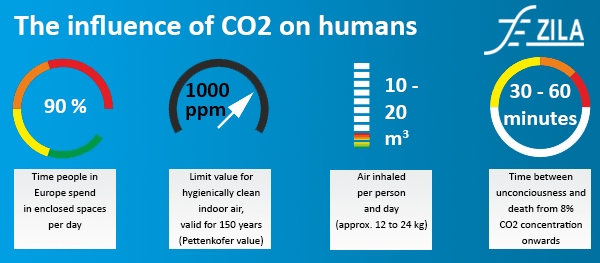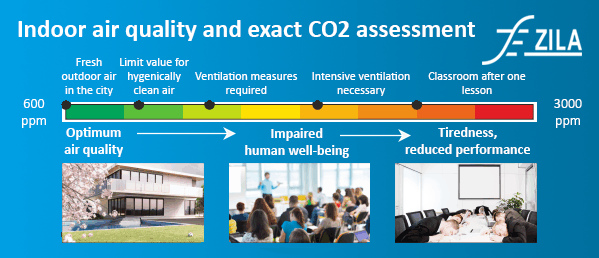 The influence of CO2 on the air quality and our daily lives
The influence of CO2 on the air quality and our daily lives
- Written by ZILA GmbH
- font size decrease font size increase font size
The influence of CO2 on the air quality and our daily lives

CO2 is a natural component of our atmosphere. The total amount of CO2 in dry air is about 0.038 % or 380 ppm (parts per million). This low concentration is harmless to humans. However, the invisible gas is colourless, odourless and heavier than air, which can lead to dangerous situations in any residential, living and working environment - especially for children, but also for adults.
In enclosed spaces and at increased concentrations, CO2 can accumulate near the ground and thus impair your well-being and health!
| Examples | ||
| In our workspaces | In residential and living areas | In our daily lives |
|
|
|
Especially where large crowds of people gather in enclosed spaces, the adverse effects of too high CO2 levels should not be underestimated.
Dealing with carbon dioxide: CO2 poisoning leading to life-threatening situations
For 150 years, the concentration of carbon dioxide has been considered an indicator of indoor air quality (Pettenkofer value). Elevated CO2 levels in living and working spaces as well as in passenger compartments have been proven to cause various problems and resulting symptoms. For example, headaches and dizziness as well as tiredness and a lack of energy are potential symptoms indicating that the CO2 concentration in the air is too high. The result of that is reduced performance due to the fact that less oxygen can be absorbed.
Did you know that exhaled air already contains a CO2 concentration of about 40,000 ppm?
The below table in the next section illustrates that this can quickly become dangerous in enclosed spaces without ventilation.
CO2 guidelines and possible health hazards
The following list includes everyday life situations and the CO2 concentrations measured therein:
ppm |
Air quality |
Action required |
| 350 - 700 | good | City air outdoors; recommended for lounges |
| >1,000 | marginal | Limit value for hygienically clean air (Pettenkofer value); ventilation measures required |
| 800 - 1,400 | bad | Limit value for office spaces; measured in poorly ventilated flats |
| 1,400 - 3,500 | contaminated | Measured values in classrooms after one lesson; intensive ventilation necessary |
| >2,000 | inacceptable | Ventilation concept required! |
| >3,500 | inacceptable | Maximum values after a film in the cinema |
| 40,000 | Exhaled air | |
| 80,000 | life-threatening | Breathing difficulties, cognitive disorders, loss of consciousness |

CO2 concentration measurement with a carbon dioxide sensor
Humans cannot detect carbon dioxide, which is why technical solutions are essential for that.
The best way to detect the exact amount of CO2 in the room air is to use precise CO2 sensors. A well-known and proven method for determining the carbon dioxide concentration with a sensor is the optical measuring method 'NDIR'. CO2 sensors with this measuring method are an ideal solution because on the one hand they are maintenance-free and on the other hand they have a long service life. NDIR is short for 'non-dispersive infrared absorption measurement'. This involves infrared radiation penetrating the air (as a mixture of gases) and measuring the absorption of a specific wavelength in the infrared spectrum.
Ventilation depending on the prevalent CO2 concentration
Based on the measured CO2 level, measures can be taken to protect people and ensure their well-being. For most of the rooms, it is already sufficient to control fans on the basis of the measured CO2 values. In areas where CO2 is involved in the work process, for example in beverage production, cooling rooms and systems and combustion processes, gas detectors and warning devices for carbon dioxide are necessary. These devices can send out warning signals in the event of a leakage and thus protect people and machinery.
More information
Site map: Gas detection
